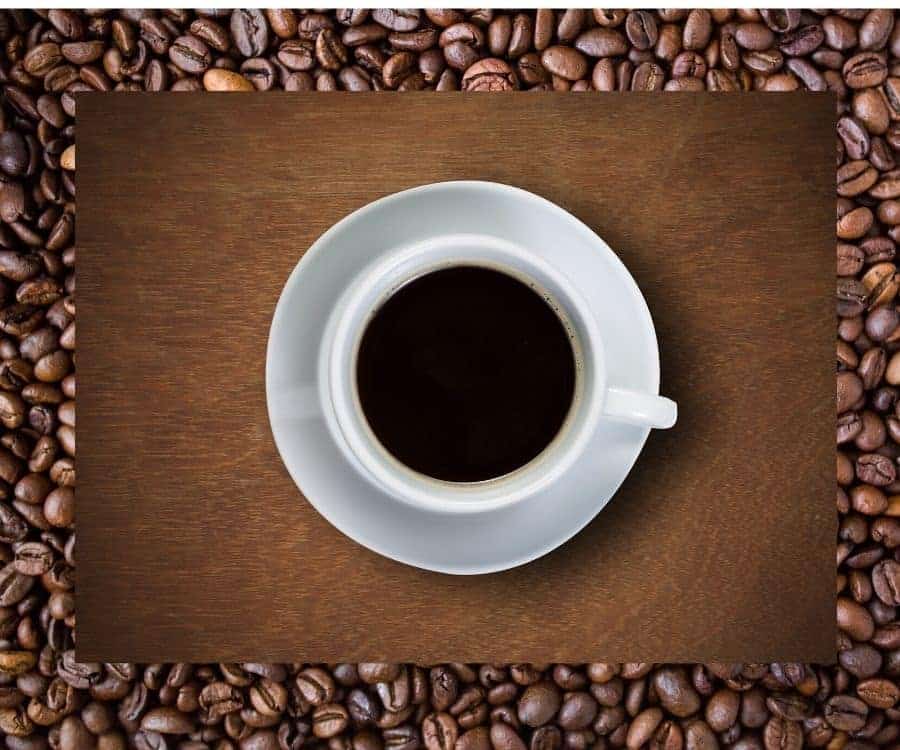
The following are reasons why your coffee can taste bitter:
- Too much coffee per water
- Water temperature too high
- You are using dark roast beans
- Too long a brewing time
- Type of method to brew coffee
- The grind of the coffee is very fine
- Your equipment is not clean
- The coffee is very recently roasted
Carry along this post to further explain these reasons with some science behind them.
Overextraction
Coffee contains many components that give its distinctive flavor. The coffee bean is an incredible and amazing seed capable of delivering such complexity in flavor and fragrance. All the steps of the process that transform it from a raw bean or fruit to a coffee drink are involved in the development of the final flavor, from the farming to the brewing of the cup.
However, along this process, there are some factors that can cause a coffee drink to taste bitter that we will be addressing in this article.
So first, let’s discuss the term extraction.
As Easto (2017) describes in her book Craft Coffee,
“Extraction is the process of pulling flavor and texture compounds from the coffee ground into the brewed coffee”
Easto (2017)
She describes that there are four types of compounds in coffee:
- Insoluble solids
- Insoluble oils
- Soluble gases
- Soluble solids
Soluble means that the substance can dissolve in water. While insoluble is the contrary, it can not be mixed with water. Just like oil and water, when you put them together you will always see the drops of oil, that is because the oil cannot be dissolved in water.
Amongst these described components, the soluble solids are mainly responsible for the flavor of the coffee, which means how sweet, acid, or bitter a coffee can taste.
So what happens when the ground coffee is in contact with water can be described in three steps (according to Easto):
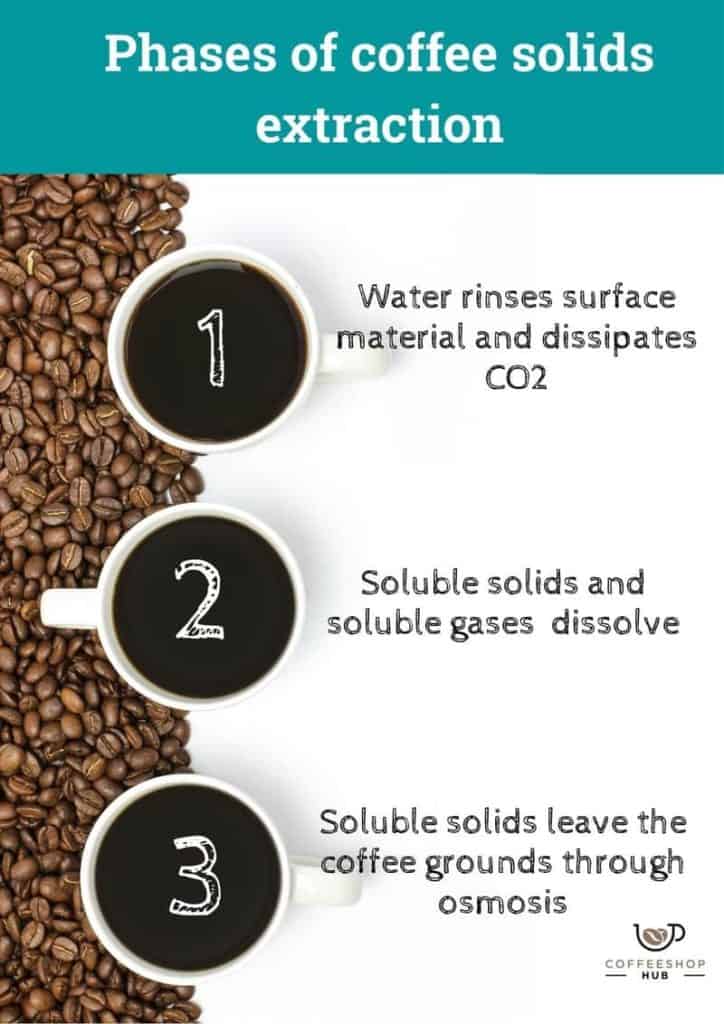
- Water rinses the grounds taking away any surface material as well as displacing carbon dioxide (CO2).
CO2 is a gas that is formed during the roasting process. It is one of the components that give a bitter flavor and is the reason why freshly roasted coffee can give away a bitter flavor when it is brewed just a few days from roasting.
Many people like to wait at least a couple of days after roasting to brew coffee.
On the other hand, there is a process called blooming. This involves adding a little bit of water at the beginning of the brewing and waiting about 30 seconds for the bubbles to dissipate. These bubbles are the carbon dioxide, and therefore blooming is a way to lessen the CO2 bitter-tasting effect on your cup.
- Soluble solids and soluble gases start to dissolve or mix, with the water.
This is where the aroma and flavor of the coffee start to form.
- These soluble solids leave the coffee grounds through osmosis.
Osmosis is a process that results in solids leaving from a more concentrated area to a less concentrated area. So it is the components leaving the ground coffee and heading toward the brewing liquid and hence the coffee is formed.
So the most interesting thing about the coffee soluble solids is that depending on the type of solid it will be dissolved at earlier stages of the brewing.
Type of coffee soluble solids
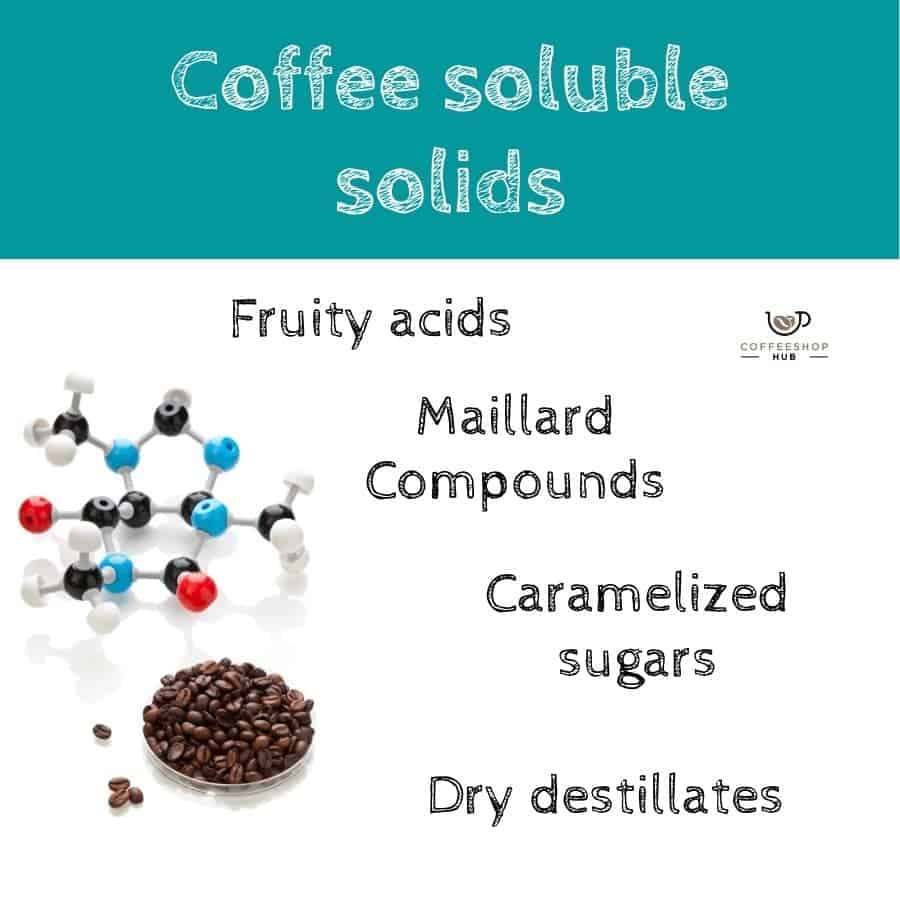
Fruity acids are the ones that dissolve at the beginning. They have the smallest molecule.
Next, come the Maillard compounds. These are more complex substances that are formed during the roasting process. They can be seen as well when you toast your bread for example. They are dark substances that result from the reaction of sugars and proteins in the presence of heat.
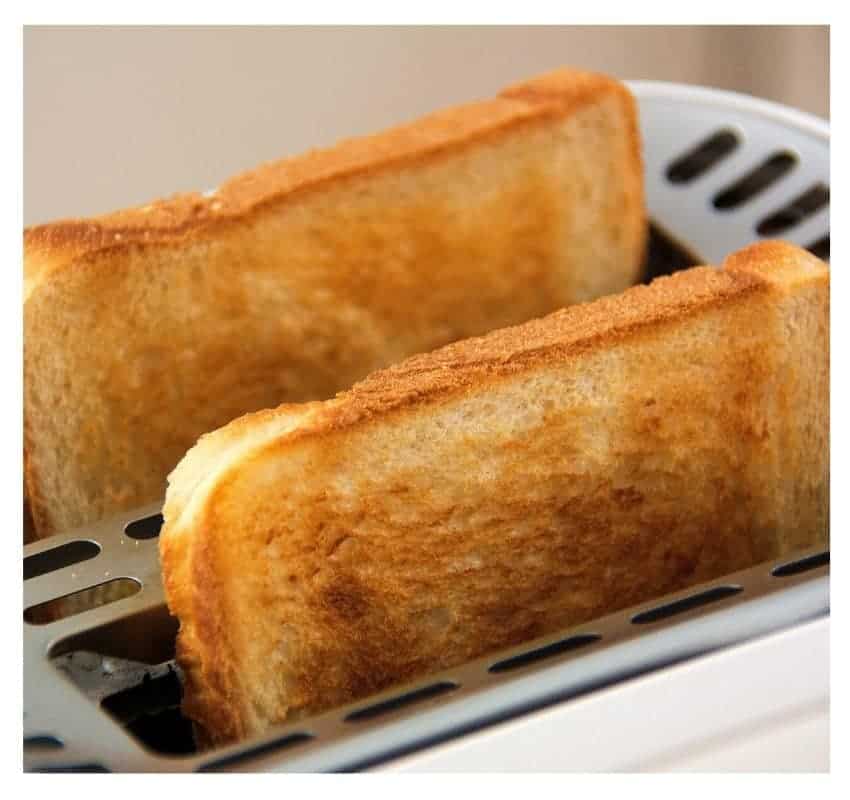
Then comes the browning sugars or caramels. These are also formed during the roasting process because of the effect of heat over sugars.
The longer the roasting process the more Maillard components and browning sugars you will have. The components that are formed in these reactions, that give great flavor and aroma, will start to transition from a caramel flavor to a burnt flavor.
But also, other components will start to form, called dry distillates, that also give bitter flavors. This is the reason why dark roasts taste more bitter than medium or light roasts.
When these bitter substances have being formed because of prolonged contact with heat, they tend to mask the other flavors, like the fruity acidity or sweetness, so the cup of coffee tastes bitter altogether.
Overextraction: when your cup of coffee has too much of the bitter components because of prolonged contact with heat.
When making a cup of coffee you are looking for a balance between all of the flavors: acidity, sweetness, bitterness, and all others. There are experts who can identify other flavors like chocolate, nut, specific fruits like plums, and lots more.
So you do require some bitterness for a cup of coffee to taste nice and balanced, but the problem is when that balance is tilted towards lots of bitter substances hence obtaining a bitter cup.
Other factors that make your coffee taste bitter
So we discussed about the effect of roasting on the type of components that can be found on coffee and its relation with the bitter flavor.
Lets now discuss other factors involved, and that can be controlled by the person brewing the cup.
Water temperature
The ideal water temperature for brewing a cup of coffee is from 90 Celsius or 194 Fahrenheit to 96 Celsius or 205 Fahrenheit (Easto, 2017)

Below this temperature, you will get acidic substances and afterwards you will get the dry distillates that are bitter.
At home when making coffee using a coffee maker I used to feel that my coffee was acid. Then I started making coffee by using a Kalita method and a water boiler with a thermometer incorporated.
I started to make my coffee controlling the temperature, making sure that when I poured coffee it was in the described temperature range. The difference in flavor was amazing.
When I was about to go below 90 celsius or 194 Fahrenheit I would heat up water again for a few seconds, and when it was too hot I would wait until it went down. This way I made sure that the water was at the right temperature. The difference was amazing and this turned out to be my favorite method for brewing coffee.
So I went back to my coffee maker and put a thermometer to measure, and to my surprise, the temperature was at 80 celsius or 176 Fahrenheit.

Suddenly I had an explanation for why my coffee tasted more acidic when made with the coffee maker in comparison to Kalita. The coffee maker was unable to heat water enough to obtain a balanced cup.
What is Kalita: it is a method for pouring coffee by passing water through ground coffee that is in a paper filter. The floor of the Kalita cup has three holes that regulate how much-brewed coffee goes down through gravity and therefore it controls this way the brewing time and therefore how much time coffee is in contact with hot water.
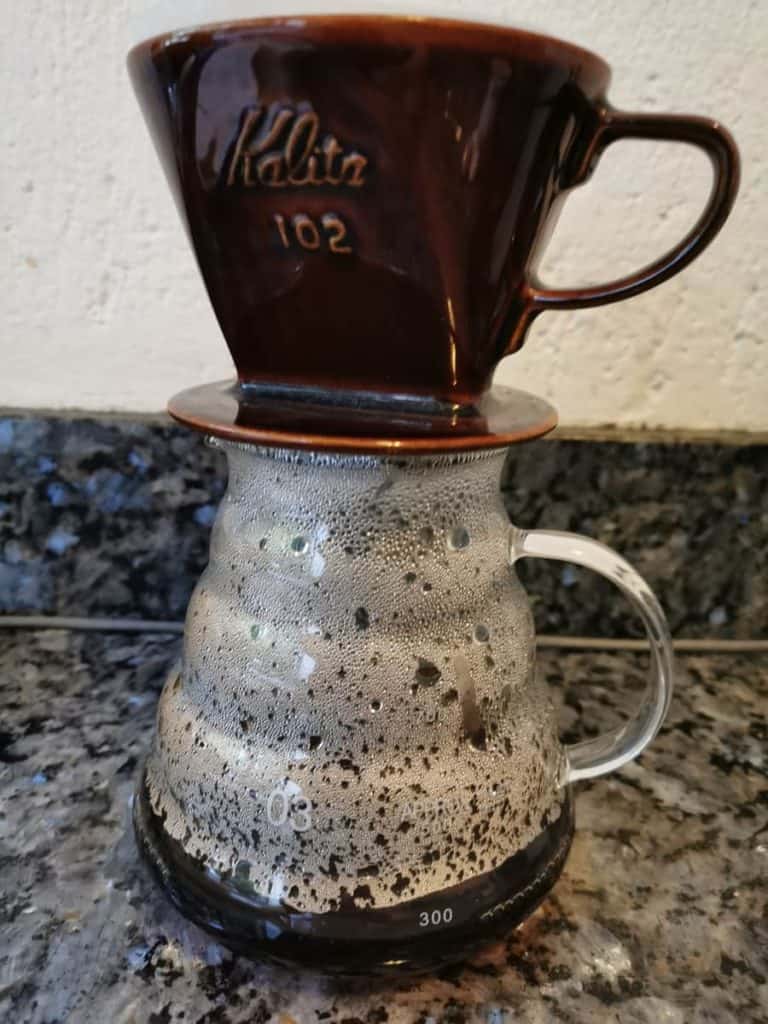
It is important to know that when you boil coffee the temperature will usually be higher than 205 Fahrenheit or 96 Celsius. The temperature at which water boils changes with altitude. On the beach, the boiling temperature is closer to 100 celsius or 212 Fahrenheit while on high mountains it will be closer to 96 celsius (205 Fahrenheit) depending on the altitude.
So usually when you boil water you will have to wait about 30 seconds, depending on where you live, for the water temperature to go down. So try to avoid brewing coffee with water right after it boils, for this can result in an over-extraction and therefore bitterness.
Contact time between coffee and water
So the same explanation as before applies to the contact time of hot water and coffee. The more time the coffee is in contact with water, the more dry distillates will be formed, and the more Maillard components will be dissolved, giving your coffee drink a more bitter taste.
Brew ratio: coffee to water
The usual recommendation is a 1 to 15 relation of coffee to water. This means that for every part of coffee you will put 15 parts of water. This is close when you say that you will use two scoops of coffee for every 6 ounces of water, which is a common recommendation if you do not have a scale to measure coffee by weight.
So if you add fewer parts of water for every part of coffee your coffee will taste stronger, and this can also feel more bitter.
How fine or coarse your coffee is and your brewing method
When you grind your coffee you are reducing its size. Many people have a mill at home that they can use to ground coffee to the desired particle size. In general, you can describe this as coarse, medium, or fine ground.
A fine particle will have more surface exposed and therefore will be more propane to over-extraction. This is adjusted depending on the brewing method.
For example, when you make an espresso coffee by using an espresso machine, the water is in contact with the coffee for a small fraction of time, around 2o to 30 seconds. Therefore a fine ground coffee is needed so that the extraction will be adequate.
On the other hand, if you are using a percolator, it will be better to have a coarse coffee to reduce exposure.
So, if you are grinding your own coffee and feel your coffee bitter, one variable you can control is reducing your grind size, making it more coarse, to see if this has an effect on your coffee bitterness.
Cleanliness of equipment
Earlier we discussed that coffee has insoluble soils. When you use your equipment and do not regularly clean it, these oils will stick to your equipment, start to oxidize or become rancid. These flavors will pass to your coffee drink and give a bad flavor.
How to make your cup of coffee less bitter
With the information given before try to analyze what can the situation be for your coffee that makes it bitter.
- Are you using boiling water to brew your coffee?
- Are you buying a dark roast coffee?
- Are you using a freshly roasted coffee?
- Are you grinding too fine?
- Is the coffee having contact with the water for too long time?
- Are you using the adequate water to coffee ratio?
- Is your equipment clean?
Try to change one variable at the time and evaluate the effect on your cup of coffee. The important thing is to try to understand what is going so you can make adjustments and enjoy your coffee
Finally, try testing different types of coffees. Sometimes, you just need to test until you find one that you love. After finding it there is no going back.
References
Easto, Jessica (2017). Craft Coffee: A Manual: Brewing a Better Cup at Home. Chicago. First edition.
